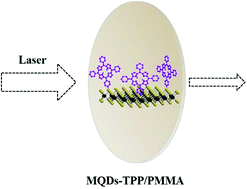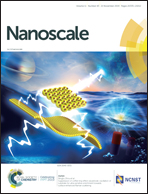MoS2 quantum dots chemically modified with porphyrin for solid-state broadband optical limiters†
Abstract
MoS2 quantum dots (MQDs) with unique electronic and optical properties are promising broadband nonlinear optical (NLO) materials for ultrafast optical applications. It would be very interesting and challenging to functionalize MQDs with another hotspot optoelectronically active molecule “porphyrin”. Herein, by treating MQDs with tetraphenylporphyrin (TPP) diazonium salts, we synthesized a novel nanohybrid material, MQD-TPP, in which TPP was covalently functionalized to the surface of MQDs via a C–S linkage. To explore its solid-state broadband NLO application, the MQD-TPP nanohybrid was encapsulated into a poly(methyl methacrylate) (PMMA) matrix for the open-aperture Z-scan measurements at 532 and 1064 nm. In contrast to MQDs/PMMA and TPP/PMMA, the MQD-TPP/PMMA film exhibited superior nonlinear optical and optical limiting responses with the largest nonlinear coefficients (βeff) and the lowest optical limiting (OL) thresholds of about 1059.17 cm GW−1 and 1.62 J cm−2 at 532 nm and 831.13 cm GW−1 and 1.97 J cm−2 at 1064 nm, respectively.

- This article is part of the themed collection: 2019 Nanoscale HOT Article Collection


 Please wait while we load your content...
Please wait while we load your content...